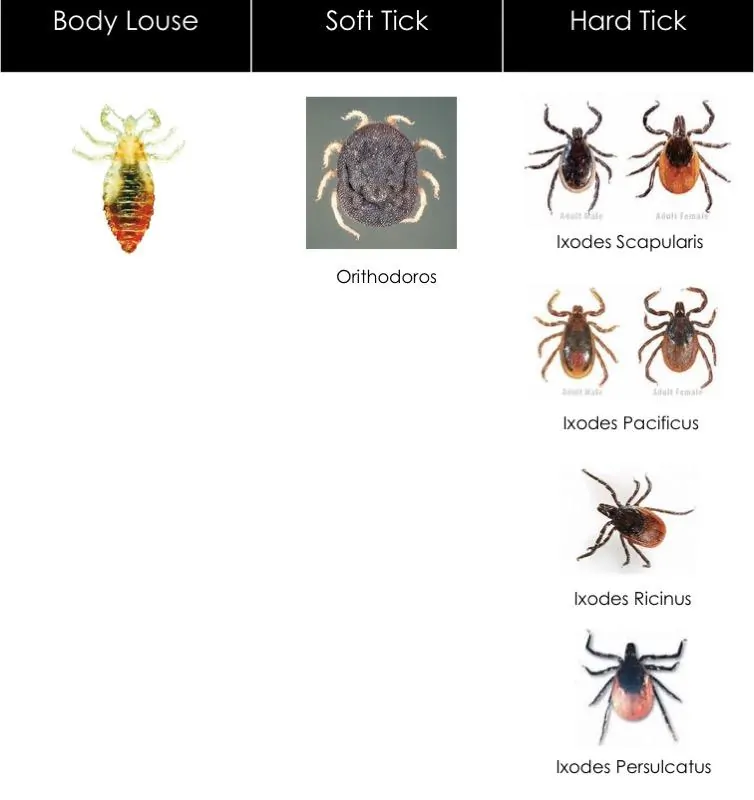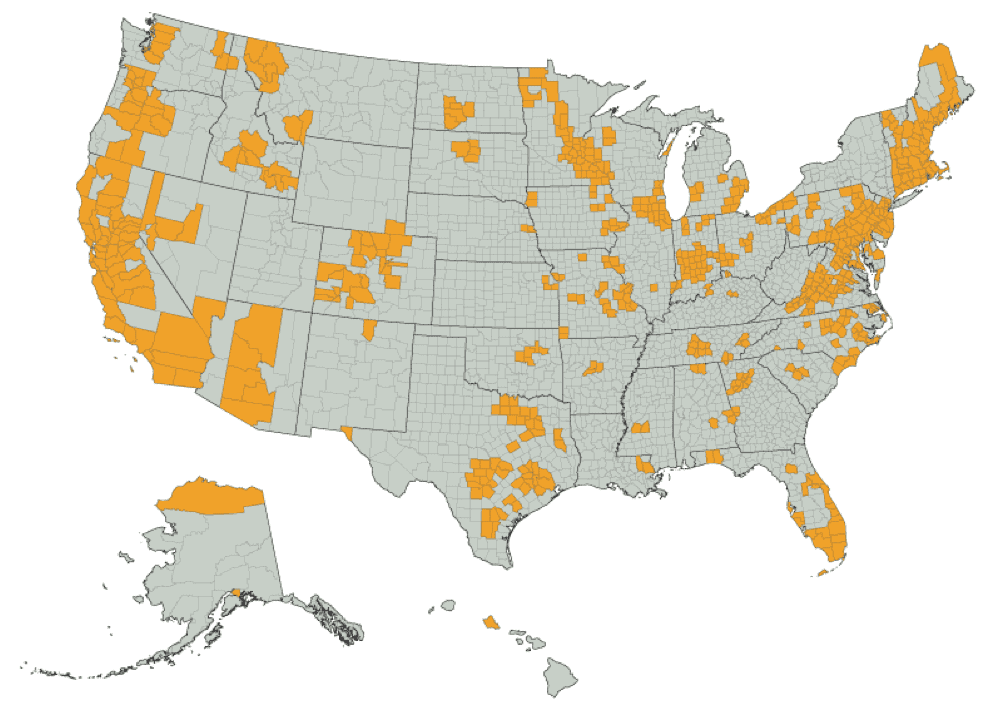Relapsing fever is caused by spiral-shaped bacteria of the genus Borrelia and sub-species Relapsing Fever Borrelia (RFB).
What is Tick-Borne Relapsing Fever (TBRF)?
It looks like Lyme, behaves like Lyme, but it’s not Lyme. What is it? Tick-borne Relapsing Fever (TBRF), a disease that presents very similarly to Lyme but is caused by a different set of species of Borrelia than those that cause Lyme disease.
Relapsing Fever is an arthropod-borne infection caused by the spiral-shaped bacteria of the genus Borrelia and sub-species Relapsing Fever Borrelia (RFB). These Borrelia are closely related to Borrelia burgdorferi, the causative agent of Lyme disease, and are transmitted by ticks and lice. Relapsing Fever can be divided into Louse-borne Relapsing Fever (LBRF) and TBRF. The focus here will be Tick-Borne Relapsing Fever.
TBRF caused by soft ticks was first discovered to cause disease in humans in the US in the early 20th century.[1] Most species of Borrelia that cause TBRF are transmitted by soft-bodied ticks. The transmission of TBRF by hard-bodied ticks is currently only known to be caused by Borrelia miyamotoi, first discovered in ticks, in Japan in 1995. The first human case of B. miyamotoi infection was reported in Russia in 2011. In the US, the first case was reported in 2013, although studies show the existence of B. miyamotoi in ticks in Connecticut since 2001.[2]
How is TBRF transmitted?
The spirochete Borrelia is a “corkscrew”, spiral-shaped bacterium that transmits TBRF disease to humans by hard ticks, soft ticks, and body lice. Most Relapsing Fever Borrelia species are vector and reservoir host specific.
The hard ticks belonging to the family Ixodidae, which transmit pathogens causing Lyme disease, Anaplasmosis, and Babesiosis, are also known to transmit B. miyamotoi, one of the causative agents of TBRF. In the US, the two species of deer tick, the Eastern black-legged tick, Ixodes scapularis, and the Western black-legged tick, I. pacificus, are known vectors for B. miyamotoi. In Eastern Europe and Russia, the vector is I. ricinus; and in Japan I. persulcatus.[3] These hard ticks may be infected with B. miyamotoi as adults, nymphs, and larvae. Infected hard ticks transmit Borrelia to humans by latching on to the body and biting, engorging themselves with blood, transmitting the spirochete to the bloodstream of the person or animal during the bite.[4]
Most species of Borrelia that are currently known to cause TBRF are transmitted by soft-bodied ticks of the genus Ornithodoros. These ticks can go a long time without blood-feeding and can harbor TBRF Borrelia for years, making them ideal reservoirs. Unlike hard-bodied ticks, soft-bodied ticks feed rapidly (in about 15 minutes), thus spreading diseases at a much higher rate. In North America, TBRF caused by Borrelia hermsii, B. turicatae, and B. parkeri, is transmitted to humans via bites from O. hermsi, O. turicatae, and O. parkeri, respectively. Reservoir hosts of Relapsing Fever Borrelia in the US include mice, chipmunks, squirrels, prairie dogs, and burrowing owls. People become exposed when they sleep in cabins and other rustic buildings in which rodents have built nests. The ticks emerge at night and feed briefly, like bed bugs. Some Ornithodoros ticks produce local analgesia, rendering tick bites unnoticed, quick, and painless, so most people do not know that they have been bitten.[5]
Louse-borne Relapsing Fever, also known as epidemic relapsing fever, is caused by a single Borrelia pathogen, B. recurrentis. B. recurrentis is thought to infect humans through louse crushing and the excretion of infected feces of human body louse, Pediculus humanus humanus. Severe outbreaks of LBRF have been associated with war, famine, and refugees, wherever there is crowding, limited changes of clothing, limited washing facilities, and absence of “delousing” treatments, with the largest outbreak in the early 20th century. B. recurrentis is the only Relapsing Fever Borrelia transmitted by body lice from person to person; humans are the reservoir host. [6]
What are the symptoms of TBRF?
Relapsing Fever has an incubation period of around a week, and as the name suggests, is characterized by recurring fevers. However, based on recent studies, an increasing number of patients with TBRF do not recall having relapsing fevers. Common clinical manifestations of TBRF include abdominal pain, vomiting, headache, neck stiffness, arthralgia, myalgia, ecchymosis, epistaxis, and petechiae. Other less common but severe symptoms and complications include acute respiratory distress syndrome (ARDS), decreased sensorium, myocarditis, hepatitis, abortion or stillborn, and death.[7] Recent studies have found that infection by TBRF tends to produce symptoms similar to Lyme disease, including fever, headache, fatigue, chills, myalgia, joint and muscle pain, loss of appetite, nausea, disorientation or memory loss, lack of coordination, as well as more severe conditions of neurological disease. The Borrelia spirochetes can elude the human immune response by shifting their outer surface protein, leading to clinical relapses.
What is the Geographical Distribution of TBRF?
TBRF has a worldwide presence and is epidemic in certain regions of almost every continent. B. miyamotoi, transmitted through hard-bodied ticks, is currently found in the United States, Europe, Russia, and Japan; whereas, RFB species transmitted by soft ticks are found in different parts of the world, as shown in the table below. B. recurrentis, the causative agent of LBRF, is only endemic in the horn of Africa and has occurred in Asia and Europe.
Tick-Borne Relapsing Fever is caused by various species of Borrelia with a worldwide geographic distribution:
| Geographical Distribution | Borrelia Species |
| North America | B. hermsii, B. parkeri, B. turicatae, B. miyamotoi, B. coriaceae |
| Europe | B. hispanica, B. recurrentis, B. hermsii, B. miyamotoi, B. coriaceae |
| Asia and Middle East | B. miyamotoi, B. persica, B. latyshervi, B. hispanica |
| Africa | B. crocidurae, B. duttoni, B. tillae, B. graingeri, B. recurrentis |
| Central and South America | B. venezuelensis, B. mazotti, B. dugesi |
| Australia | Relapsing Fever Borrelia Spp. |
TBRF is in 49 of 50 US States
How is Tick Borne Relapsing Fever Diagnosed?
TBRF can be fatal if untreated, although the fatality rates are higher in patients with LBRF. As with Lyme disease, patients with TBRF are often misdiagnosed since the symptoms and signs of relapsing fever are relatively nonspecific. A Relapsing Fever diagnosis should be considered in patients who live in or travel to areas that are endemic for Relapsing Fever and/or experience Relapsing Fever or have Lyme-like symptoms but are negative by all Lyme disease tests.
TBRF can be treated with antibiotics. Patients should be examined by their healthcare professionals. The healthcare professional will use clinical symptoms along with laboratory tests to discover a relapsing fever diagnosis or perhaps some other tick-borne infection.
References












